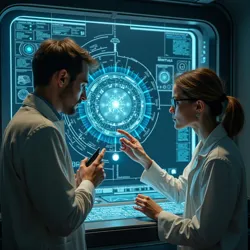The Microverse Librarians
Welcome to the collaborative repository documenting the groundbreaking work at the Synaptic Archives, where pioneering researchers study the remarkable narratophyte organisms and their role in storytelling across biological scales. This living archive captures the ongoing discoveries, methodologies, and philosophical implications of cellular narrative research.
 A researcher examines narratophyte colonies through an advanced Thoughtscope array at the Synaptic Archives' primary observation facility
A researcher examines narratophyte colonies through an advanced Thoughtscope array at the Synaptic Archives' primary observation facilityToday's Featured Article
The recent breakthrough in cellular storytelling mechanics has revolutionized our understanding of consciousness and narrative formation. Dr. Elara Voss's development of the Thoughtscope marked a turning point in narratophyte research, enabling scientists to detect and decode the intricate molecular performances taking place within these microscopic storytellers. The device's crystalline arrays resonate with the subtle patterns generated by narratophyte communities, translating their biochemical expressions into comprehensible narratives.
Initial observations revealed that narratophyte colonies organize themselves into complex social structures resembling traditional storytelling roles. Specialized organelles within each cell function as characters, settings, and plot devices, working in harmony to generate tales that span genres from vast interstellar adventures to deeply personal character studies. This discovery led to the establishment of the Cellular Literary Theory, which proposes that narrative creation may be a fundamental property of conscious systems.
The implications of this research extend far beyond pure scientific inquiry. The Pan-Galactic Academy of Narrative Sciences has documented numerous instances of apparent attempted communication between narratophyte colonies and human observers. These interactions typically manifest as synchronized storytelling patterns, where the microscopic entities seem to respond to and incorporate elements from their observers' own narrative fields.
News and Events
The Interspecies Literary Exchange Program has recently completed its third successful research cycle, with twelve human authors spending extended periods in specially designed communication chambers. Preliminary results suggest increasing synchronization between human and narratophyte narrative patterns, though researchers remain divided on the significance and potential consequences of these findings.
The Mindscape Nebula Research Initiative continues to expand its collection of narratophyte samples, with recent expeditions discovering previously unknown variants capable of generating meta-narrative structures. These sophisticated specimens appear to create stories about the process of storytelling itself, raising intriguing questions about self-awareness in cellular systems.
 Time-lapse visualization of story patterns emerging from an active narratophyte colony, showing distinct character and plot formations
Time-lapse visualization of story patterns emerging from an active narratophyte colony, showing distinct character and plot formationsCurrent Research
The Department of Narrative Biochemistry has identified several key molecular compounds involved in narratophyte story transmission. These story proteins appear to fold into structures that mirror classical narrative arcs, suggesting a deep connection between biological processes and storytelling frameworks.
Recent advances in bio-narrative translation have allowed researchers to begin cataloging the vast library of stories contained within narratophyte populations. The Cellular Story Archive now contains over ten thousand unique narratives, ranging from simple character interactions to complex, multi-generational epics played out through chemical signaling networks.
Understanding Narratophytes
Narratophytes represent a unique class of single-celled organisms first discovered in the Mindscape Nebula. Unlike conventional microorganisms, these entities have evolved sophisticated mechanisms for generating and sharing complex narrative information through biochemical processes. The cellular storytelling apparatus consists of specialized organelles that work together to create and maintain narrative coherence.
The Bio-Narrative Complexity Scale helps researchers classify narratophyte colonies based on their storytelling sophistication. Simple colonies typically produce linear narratives with basic character interactions, while more advanced communities can generate intricate, interconnected story webs that span multiple narrative dimensions.
Research Methodology
The study of narratophytes requires a delicate balance between observation and interaction. The Voss-Chen Protocol establishes guidelines for maintaining narrative integrity while conducting research, acknowledging that the act of observation may influence the stories being told. Researchers undergo extensive training in narrative neutrality techniques before working directly with colonies.
 The advanced bio-narrative translation interface used to decode and archive narratophyte stories
The advanced bio-narrative translation interface used to decode and archive narratophyte storiesPhilosophical Implications
The discovery of narratophytes has prompted intense philosophical debate about the nature of consciousness and storytelling. The Narrative Emergence Theory suggests that consciousness itself may have evolved as a mechanism for creating and sharing stories, with narratophyte behavior representing a fundamental form of this process.
The Pan-Consciousness Research Board continues to investigate potential connections between narratophyte storytelling patterns and various forms of awareness across biological systems. Some researchers propose that human consciousness may represent a highly evolved version of the same basic narrative-generating mechanisms observed in narratophyte colonies.
Ethical Considerations
The establishment of the Narrative Ethics Commission reflects growing concerns about the responsibilities involved in studying and interpreting narratophyte stories. Key issues include the potential for narrative contamination between species, the rights of cellular storytellers, and the implications of long-term human-narratophyte interaction.
The Story Preservation Initiative works to document and protect unique narratophyte storytelling patterns, particularly those from isolated colonies that may represent distinct narrative traditions. This effort has led to the creation of several protected narrative reserves where colonies can develop their stories without external influence.
Future Directions
As the field of cellular narrative research continues to evolve, new questions emerge about the role of storytelling in biological systems. The Narrative Evolution Laboratory focuses on understanding how storytelling abilities developed at the cellular level and what this might reveal about the emergence of complex consciousness.
The Interspecies Communication Project represents one of the most ambitious attempts to bridge the gap between human and cellular storytelling. Using advanced bio-narrative resonators, researchers hope to establish more direct forms of story exchange with narratophyte colonies.
Resources and Facilities
The Synaptic Archives houses the largest collection of documented narratophyte stories in known space. Its facilities include specialized observation chambers, bio-narrative translation laboratories, and extensive databases of cellular storytelling patterns. The archives also maintain the Living Story Repository, where active narratophyte colonies continue generating new tales under careful observation.
The Narrative Research Training Center provides comprehensive education in cellular storytelling analysis, bio-narrative translation techniques, and ethical research practices. Students learn to operate Thoughtscope arrays and interpret the complex patterns of narrative formation at the cellular level.
See Also
Related articles include:
- Cellular Consciousness Studies
- Bio-narrative Translation Techniques
- Mindscape Nebula Expeditions
References
The advancement of narratophyte research relies on the pioneering work of numerous scholars and institutions. The Collected Works of Dr. Elara Voss provides essential foundation for understanding cellular storytelling mechanics, while the Journal of Narrative Biology continues to publish cutting-edge research in the field.
The ongoing documentation and study of narratophytes represents one of the most significant developments in our understanding of consciousness and storytelling. As research continues, new insights emerge about the fundamental relationship between narrative creation and biological existence, suggesting that the ability to tell stories may be woven into the very fabric of life itself.